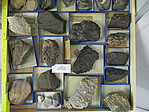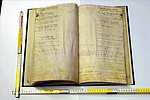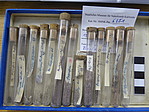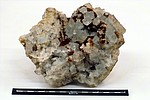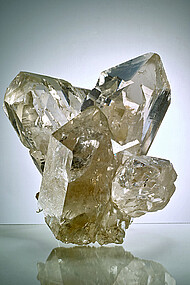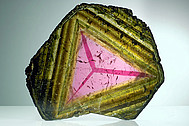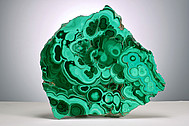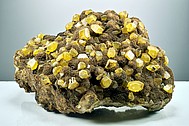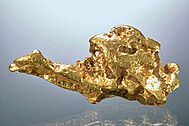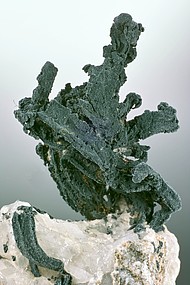Collections of the Geology, Mineralogy �and Sedimentology section
The section Geology, Mineralogy and Sedimentology is in charge of two collections: the Mineralogical Collection (isolated crystals and mineral compounds) and the Geological-Petrographical Collection (rock specimen).
Mineralogical Collection
The Mineralogical Collection of the SMNK currently comprises about 40,000 specimens. Its origin lies in valuable historical collections that were once assembled by Margravine Karoline Luise of Baden. Her “Small Collection” was a donation from the empress Maria Theresa, the “Russian Collection” was a gift from tsar Alexander I. Caroline Luise of Baden also collected polished plates of regional rocks found and quarried throughout Baden-Württemberg. Unfortunately, parts of the historical collection got lost during World War II. During the 20th century the collection was further complemented by several acquisitions.
The systematic part of the collection covers all mineral classes (e.g., silicates, oxides) and contains a large number of native elements (e.g., sulfur, copper, lead), including artificial i.e. industrial minerals. The specimen were gathered both in Baden-Württemberg and worldwide. The mineral specimen are of unique purity, quality and rarity. Reference samples are an additional part of the collection. These samples were scientifically analyzed and the results were published.
The economic-geological part of the Mineralogical Collection focuses on regional parageneses (e.g., barite, fluorite, nonferrous metals) quarried in the Black Forest during historical times (e.g. Grube Clara). Most sites are no longer accessible.
The SMNK also owns a collection of meteorites and tektites from all over the world. Meteorites have a cosmic origin, while tektites are earth rocks that got modified by immense pressure and very high temperatures during a meteorite impact. The collection includes numerous samples of the Ries Impact that occurred in southern Germany about 15 million years ago.
Geological-Petrographical Collection
The State Museum of Natural History owns a historical Geological-Petrographical collection that currently comprises about 9,000 rock specimens. The collection is ordered by the three main rock types magmatites (volcanites and plutonites), metamorphites and sedimentary rocks. The collection also contains an overview of geological features, such as tectonic structures (e.g., folds and cleavages), sedimentary structures (e.g., crossbedding and grading), as well as evidence of surface processes like weathering (e.g., karstification) or glaciation (e.g., striation).
One of several collections with historical value is the collection of Professor Dr. K. Futterer. Prof. Futterer, born in Stockach, and his expedition team travelled though Central Asia from 1897 to 1899. They visited Turkestan, the Pamir Mountains, Kaxgar, the northern silk road, the Yellow River, eastern Tibet, the Gobi Desert, China and finally ended in Shanghai. The collection includes both various rock samples, but also the original field notes of Prof. Futterer.





